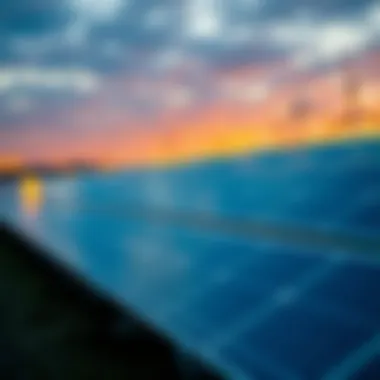Understanding the Dynamics of Feed-in Tariffs in Energy


Intro
In today’s rapidly evolving energy landscape, a significant shift is unmistakably underway. As the world grapples with climate change and seeks sustainable solutions, feed-in tariffs have emerged as pivotal tools in promoting renewable energy investment. Understanding the workings of these tariffs provides insights into how they sculpt the energy sector and influence both economic growth and environmental sustainability.
Investment Terminology Breakdown
Grasping the intricacies of feed-in tariffs mandates a firm understanding of certain investment terminologies. For many investors and financial advisors, the jargon that surrounds renewable energy financing can appear daunting, but breaking down these terms can shed light on the underlying mechanics of feed-in tariffs.
Common Investment Terms Explained
To fully appreciate how feed-in tariffs operate, consider familiar investment terms like:
- Return on Investment (ROI): A crucial metric that measures profitability. In the context of feed-in tariffs, ROI helps investors evaluate the financial viability of renewable projects.
- Net Present Value (NPV): This refers to the difference between the present value of cash inflows and outflows over a period. For renewable projects, NPV calculation aids in understanding the long-term benefits of engaging in feed-in tariff programs.
- Levelized Cost of Electricity (LCOE): A term used to compare the cost of producing energy across varying technologies. This plays a significant role when considering the financial prospects of renewables under feed-in tariff schemes.
Understanding Financial Jargon
It's not just about knowing the terms; understanding their application is equally vital. Let’s consider how these terms interact with feed-in tariffs:
- Market Rate: Feed-in tariffs are often set at rates that encourage investment while ensuring they are not excessively burdensome on consumers. Thus, knowing market rates assists investors in forecasting profits.
- Policy Framework: Each tariff system is product of careful policymaking, often tailored to the economic landscape of a region and its energy needs. Investors must be conversant with these policies to ensure compliance and maximize benefits.
By crystalizing these terminologies, investors can decipher the complexities of feed-in tariffs and effectively navigate their implications.
Financial Product Reviews and Comparisons
Investors are often faced with diverse options when considering renewable energy investments. Assessing the nuances of different financial products associated with feed-in tariffs is essential for informed decision-making.
In-Depth Product Analysis
In markets with robust feed-in tariff programs, various products catering to renewable energy projects abound. This may include equity investments in green energy companies, bonds specifically tied to renewable sector funding, or investment funds that specialize in diversified portfolios within the renewable sector. Each category comes with distinct risk profiles and potential returns, necessitating thorough analysis.
Pros and Cons of Financial Products
When weighing options in renewable investment, consider the following:
- Pros:
- Cons:
- Potential for high ROI depending on the tariff rates and project efficiency.
- Government-backed security can often lower the perceived risk.
- Opportunities to contribute to environmental sustainability and combat climate change.
- Complexity in understanding terms and conditions can deter potential investors.
- Regulatory changes can affect existing and future tariff rates, adding uncertainty.
- Initial capital requirements can be significant, posing barriers to entry.
“Navigating investment in the renewable sector is akin to steering a ship through changing tides; understanding the winds of economics and regulation is essential.”
Grasping the financial products linked with feed-in tariffs equips investors and advisors to make decisions that align with their financial goals while maintaining an eye on sustainability.
Prelims to Feed-in Tariffs
Understanding feed-in tariffs is crucial for anyone involved in the renewable energy sector. These tariffs are not just another financial policy; they are a powerful tool designed to drive the growth of renewable energy sources, promoting sustainable practices and bolstering energy independence. By ensuring producers of renewable energy receive a fair rate for the electricity they generate, feed-in tariffs create a win-win situation—encouraging investment in green technology while also helping to reduce reliance on fossil fuels.
Definition and Purpose
At its core, a feed-in tariff is an agreed-upon payment structure that guarantees individuals and companies producing renewable energy will receive payment for the electricity they supply to the grid. This payment is typically set above the market rate, ensuring that those who invest in renewable energy can see a return on investment while also contributing to the larger goal of reducing carbon emissions.
The purpose of feed-in tariffs extends beyond mere compensation. They are intended to stimulate the growth of the renewable energy market by providing the financial security necessary for investors. By establishing clear pricing and long-term contracts, governments aim to attract both local and foreign investors willing to take the plunge into green energy initiatives.
An added benefit is the environmental impact. By incentivizing renewable energy production, these tariffs help countries meet their energy demands sustainably. As a result, not only do they foster the development of cleaner energy sources, they also play a significant role in national strategies aimed at combating climate change.
Historical Context
Feed-in tariffs have roots that stretch back several decades, with one of the earliest implementations appearing in Germany in the late 1990s. The results were impressive; after instituting feed-in tariffs, Germany experienced a significant surge in renewable energy, particularly in solar and wind. This model demonstrated that guaranteed payments could effectively mobilize capital toward renewable infrastructure.
In the early 2000s, other nations took note, and similar policies began sprouting up across Europe and beyond. Countries like Spain and Italy adopted their versions of feed-in tariffs, leading to a rapid expansion in solar energy capacities.
However, it hasn't been a smooth ride. Early implementations in some regions faced pushback due to rising energy prices and concerns over the stability of power systems. Nevertheless, many nations refined their approach, integrating adjustments based on feedback from stakeholders and market conditions. This flexibility has been key in maintaining the relevance of feed-in tariffs as energy markets evolve globally.
How Feed-in Tariffs Operate
Understanding how feed-in tariffs operate is crucial in the broader context of renewable energy investment and policy. These tariffs serve as a foundational element in promoting renewable energies, helping to create a stable investment environment that appeals to investors, energy producers, and ultimately consumers. By operating on a system designed to guarantee payment for renewable energy production, feed-in tariffs present a more predictable revenue model in the ever-changing energy market. In this section, we will delve into the basic principles of feed-in tariffs and the mechanisms of payment, including fixed and variable tariffs as well as the duration of contracts.
Basic Principles


Feed-in tariffs revolve around a few core principles that underscore their effectiveness. Essentially, the structure is designed to encourage the development of renewable energy sources by providing a guaranteed payment structure for the producers. This payment is typically set above the market rate, which ensures that investors can recoup their initial investment and earn a profit over time.
A flagship characteristic of feed-in tariffs is their ability to stimulate growth in renewable energy production. They incentivize small-scale producers, such as homeowners who invest in solar panels, alongside large energy players. This democratization of energy production promotes local engagement and allows communities to take part in sustainable practices.
Mechanism of Payment
The payment mechanism for feed-in tariffs is essential to understand as it can vary significantly. The two main types include fixed tariffs and variable tariffs, and each plays a different role in influencing investor behavior and energy market dynamics.
Fixed Tariffs
Fixed tariffs offer a stable rate for energy producers, regardless of market fluctuations. This predictability is a key driver for placing investments in renewable technologies. For instance, a solar farm might receive a set tariff of $0.15 per kWh for the duration of its contract. This fixed nature effectively shields investors from potential price drops in the market, providing a comfortable cushion for financial planning.
However, one can argue that the rigidity of fixed tariffs may not always align with market realities. Since these rates do not change, they could potentially hinder flexibility or adaptation to increases in operational costs or market price variations. Yet, this structured approach often leads to higher initial interest from investors in renewable solutions, contributing meaningfully to the overall investment landscape.
Variable Tariffs
On the other hand, variable tariffs can fluctuate according to market conditions or other predetermined factors. This adaptability means that energy producers could earn more during peak demand periods when energy prices soar. So, if someone operates a wind turbine and the energy market prices rise, their direct compensation could increase as well.
The dynamic nature of variable tariffs poses its own risks. For some investors, this uncertainty may be a deterrent. For others, especially those in regions anticipating a rise in energy demand, it presents a lucrative opportunity. Understanding the balance between potential financial gains and the corresponding risks is critical for stakeholders involved.
Duration of Contracts
The duration of contracts linked to feed-in tariffs typically ranges from 10 to 20 years, offering a long-term assurance that payments will be made at the agreed-upon rate. This longevity is beneficial for investors since it enhances the feasibility of financing renewable projects. Also, it effectively ties the producers and consumers into establishing a relationship where stability is prioritized.
However, it does raise pertinent questions about responsiveness to changing energy needs and technological advancements over time. For instance, if stunning advancements in energy storage occur, locking in a tariff may limit producers from reaping the benefits of such innovations promptly.
Overall, understanding how these mechanisms interact provides valuable insights for anyone keen on navigating the renewable energy landscape efficiently. The balance between security and flexibility is a vital conversation point in determining how successful feed-in tariffs can be in the larger context of sustainability and energy policy.
Implementation and Regulation
The successful implementation and regulation of feed-in tariffs (FiTs) are crucial for their effectiveness in promoting renewable energy sources. Without a sound regulatory framework, even the most well-designed tariff systems can fall flat, failing to attract investments or generating the desired energy output.
The importance of implementation lies not only in how these tariffs are structured but also in how they are integrated into the broader energy landscape. A good implementation strategy considers local market conditions, existing energy infrastructure, and socio-economic factors that may influence the adoption of renewable energies. When well-executed, FiTs can stimulate significant investment attraction, making them a formidable tool in the fight against climate change.
Global Variations
FiTs are not one-size-fits-all; different countries adopt diverse approaches based on their unique contexts and goals. For instance, Germany has become synonymous with successful feed-in tariff policies, which have aggressively promoted solar energy through generous long-term rates. This approach has resulted in large-scale investments and a vibrant market for solar technologies. On the other hand, Japan's FiT system, though effective, has had its hurdles, particularly in managing overcapacity in the renewable sector.
Interestingly, countries like France have opted for a more variable approach by incorporating competitive bidding processes to set tariff prices. This is an example of how regulation can adapt and evolve based on experiences and lessons learned.
- Germany: Focus on guaranteed rates for a fixed duration encourages investment in solar and wind energy.
- Japan: Tariffs were initially set high but faced market saturation, requiring adjustments in response.
- France: Introduced auction systems to ensure a balance between investor security and market demands.
National Policies
Within each country, the national policies surrounding FiTs are instrumental in shaping how effectively these tariffs can influence energy markets. These policies define eligibility criteria for projects, set tariff levels, and establish the regulatory bodies responsible for overseeing the programs. Different countries may prioritize various renewable options, such as solar, wind, or biomass, based on their geographical advantages and energy needs.
For instance, the UK has rolled out its Feed-in Tariff Scheme which encourages small-scale renewable projects, allowing homes and businesses to invest in solar panels. This scheme not only diversifies energy sources but also powers the local economy by creating jobs in installation and maintenance.
However, challenges can arise in aligning national policies with market realities. If not managed carefully, changes in policy can lead to confusion or hesitancy among potential investors. Such fluctuating guidelines may deter investment just when the market needs it most.
"Clarity and consistency in government regulation are paramount; without it, investors may think twice before diving into renewable energy ventures."
Ultimately, successful implementation hinges on a thorough understanding of both local and national regulations and their interplay. Policymakers must strike a delicate balance—fostering innovation while ensuring market stability. This collaborative approach ensures that feed-in tariffs fulfill their purpose of transitioning to a more sustainable energy future.
Stakeholders in Feed-in Tariff Systems
Understanding the stakeholders involved in feed-in tariff systems is key to grasping the broader implications these tariffs have in the renewable energy landscape. Each stakeholder plays a distinct role that has its own set of benefits, responsibilities, and challenges. Their collective interactions can make or break the effectiveness of the feed-in tariff scheme. In this section, we unravel these varied players and their stakes, shedding light on how they influence the success of such programs.
Governments and Policymakers
The role of governments and policymakers is paramount in establishing and maintaining feed-in tariffs. They set the framework that governs how these tariffs operate. Essentially, these players bear the responsibility of crafting policies that foster a favorable environment for renewable energy development. By doing this, they can address key concerns like energy security and greenhouse gas emissions reduction.
Governments may consider the following factors:
- Economic Benefits: Tariffs can stimulate local economies through investments in clean energy.
- Environmental Impact: Policymakers recognize the need for sustainable energy solutions to tackle climate change.
- Regulatory Stability: Ensuring a predictable regulatory environment is crucial for attracting investments.
However, policymakers often face pressure from various interest groups. Balancing these interests while promoting renewable energy requires diplomacy and foresight. A clear understanding of stakeholders’ needs helps in creating tariffs that benefit all parties.
Investors and Energy Producers
Investors and energy producers are the driving force behind the success of feed-in tariff systems. Their willingness to invest funds in renewable energy infrastructure hinges on the assurances that these tariffs provide. These tariffs guarantee that investors receive a fixed price for the energy they produce, which significantly reduces financial risk.


Key considerations for these stakeholders include:
- Return on Investment: Investors seek attractive returns, making favorable tariff rates essential.
- Long-Term Contracts: Contracts often span years, ensuring sustained cash flow and long-term planning.
- Technological Innovation: Producers are incentivized to adopt advanced technologies that improve efficiency and reduce production costs.
Moreover, diverse investors, from individual entrepreneurs to multinational corporations, broaden the scope of energy production. This diversity facilitates innovation and helps meet energy demands more effectively.
Consumers and Their Role
Consumers hold a dual role in the context of feed-in tariffs. On one hand, they are direct beneficiaries of renewable energy solutions. On the other, their acceptance and participation are crucial for the viability of these programs. By utilizing energy generated from renewable sources, consumers contribute indirectly to reducing carbon footprints.
Consumer considerations might include:
- Cost Awareness: Understanding how feed-in tariffs influence energy prices can drive consumer support.
- Informed Choices: As more renewable options become available, the informed choices consumers make can encourage further investment in the sector.
- Community Engagement: Local energy initiatives can promote grassroots involvement and increase the societal push towards renewables.
To sum up, consumers are not just passive recipients of energy; their views and decisions can substantially influence market dynamics and energy policies.
Understanding the dynamics among the stakeholders in feed-in tariff systems not only aids in the deployment of renewable energy projects but also highlights the intricate balance of interests that must be managed.
Economic Impacts of Feed-in Tariffs
The economic ramifications of feed-in tariffs are crucial to understanding their role in the renewable energy landscape. These tariffs can significantly affect investments, job growth, and market pricing dynamics. Each of these areas contributes to a broader economic narrative that supports sustainability and encourages innovations in the energy sector.
Investment Attraction
Investment attraction is one of the most visible impacts of feed-in tariffs. By ensuring fixed payments for energy produced, these incentives draw in private investors and corporations looking for stable returns. There’s a kind of assurance, a safety net, if you will, that encourages stakeholders to take the plunge into renewable energy projects.
The reality is that many investors have been hesitant to engage in energy solutions due to unstable market prices and fluctuating production costs. Feed-in tariffs mitigate this risk by locking in rates for a significant time frame, thus smoothing the bumps along the road for financial backers. This is essential for emerging technologies and businesses seeking capital.
Some examples of successful investment attraction include Germany’s Energiewende, which has spawned a wave of investment in solar and wind technologies. The certainty provided by the country's feed-in tariff system mobilized billions of euros, catapulting Germany ahead in renewable energy adoption.
Job Creation and Economic Growth
Another essential aspect to consider is job creation. The feed-in tariff structure can bolster local economies by creating jobs in manufacturing, installation, and maintenance of renewable energy systems. The broader ripple effect extends into supply chains, spurring demand for materials and services.
Consider this: when a solar farm is built, not only are technicians and electricians needed to construct and maintain it, but there are also jobs created in logistics, project management, and research and development. The jobs created aren't just limited to construction; ongoing operations require a skilled workforce, generating employment opportunities long after the initial projects are completed.
According to various studies, regions that have embraced feed-in tariffs have seen unemployment rates decrease as local economies flourish due to the surge in sustainable energy projects. These jobs often pay well, enhancing the quality of life in the communities affected.
Market Price Effects
The interplay of feed-in tariffs and market prices is a complex issue. On one side, feed-in tariffs may influence market prices overall, especially if a significant amount of renewable energy penetrates the grid. High penetration of subsidized renewable sources can distort market prices temporarily as these energy forms often have lower marginal costs.
However, one can't overlook the long-term benefits. As the share of renewables increases, they can drive down prices due to competition and technological advancements that make them cheaper.
Key considerations in this aspect include:
- Energy Contract structures: Fixed feed-in tariffs can provide stability against volatile market prices.
- Consumer Costs: There's an ongoing debate on how these tariffs affect electricity costs for consumers and whether it balances out in the long run.
- Sustainability: As more renewables enter the market, reliance on fossil fuels may diminish, ultimately leading to healthier pricing mechanisms depending less on finite resources.
"Feed-in tariffs can be a game changer, attracting investments that fuel innovation and create jobs, while also indirectly affecting market prices in ways that can benefit consumers over time."
Challenges and Criticisms
The conversation around feed-in tariffs often sparks a mix of enthusiasm and skepticism. While these tariffs have good intentions, their implementation has encountered a range of challenges and criticisms which can’t be brushed under the rug. Addressing these elements is vital for comprehending the full picture of feed-in tariffs and their role in enhancing renewable energy production. Important aspects include financial viability, market distortions, and policy uncertainty, each of which can significantly affect the program's effectiveness and sustainability.
Financial Viability
One of the foremost concerns about feed-in tariffs is their financial viability. The sustainability of these incentives hinges on the balance between encouraging investment and ensuring that the costs remain manageable for governments and consumers alike.
- Cost of Implementation: The upfront investment required to establish renewable energy systems, like solar panels or wind turbines, can be hefty. Governments need to consider whether the long-term benefits justify these expenses.
- Revenues Relying on Tariffs: For many investors, their income from energy production hinges on consistent tariff rates. If any drastic adjustments occur, it can not only affect their bottom line but also discourage future investments in renewable energy technologies.
"Ensuring financial viability in feed-in tariff systems is just as crucial as the aim of promoting renewable energy."
Market Distortions
Feed-in tariffs can sometimes lead to unexpected market distortions. When guaranteed prices are set too high or too low, they change how renewables interact with conventional energy sources.
- Reduction of Competition: If market prices are skewed by these tariffs, traditional energy providers might find it hard to compete, which could lead to issues like blackouts when demand exceeds supply from renewables.
- Over-Subsidization: There’s also the risk of over-entering the market with too many renewable producers, driving prices down significantly, which could destabilize the entire energy market. The result? An inconsistently powered grid where neither renewables nor traditional energy sources can operate profitably.
Policy Uncertainty
A third critical issue is policy uncertainty. The dynamic nature of politics means that the frameworks governing feed-in tariffs can change. This inconsistency can act as a deterrent for potential investors.


- Regulatory Changes: Frequent changes in regulation can lead to confusion among investors. For instance, one day a tariff might be generous, and the next it might be slashed, leaving investors in a lurch.
- Long-term Planning Affected: Investors typically seek clarity and predictability when making long-term financial commitments. Unpredictable policy environments create hesitancy, making stakeholders wary of participating in government-backed programs.
These challenges and criticisms highlight a pressing need for balance. While feed-in tariffs have proven to be effective in accelerating the transition to renewable energy sources, addressing these roadblocks is essential for the long-term success of these systems.
Case Studies of Feed-in Tariffs
Studying case studies of feed-in tariffs (FiTs) provides significant insights into how these mechanisms can shape and drive renewable energy use in different contexts. By examining how particular countries have implemented FiTs, we can glean lessons about what works, what doesn’t, and what factors contribute to the success or failure of such programs.
These case studies serve multiple purposes. Not only do they illustrate the practical applications of theoretical concepts discussed earlier in the article, but they also highlight the various challenges faced by policymakers and stakeholders in the renewable energy sector. This helps investors and financial advisors understand the real-world implications of their decisions, while also offering a blueprint for potential improvements.
Germany's Renewable Energy Sources Act
Germany’s Renewable Energy Sources Act (EEG), first enacted in 2000, is often cited as a model for feed-in tariffs worldwide. The act was designed to spur investment in renewable sources of energy like wind and solar, ultimately aiming to phase out nuclear energy by 2022.
Under the EEG, producers of renewable energy are guaranteed a fixed payment for each kilowatt-hour of energy they generate. This certainty encourages investment, as it significantly reduces financial risk for investors.
Some key elements of the EEG include:
- Gradual Decrease in Tariffs: The tariffs are adjusted regularly, typically decreasing each year to account for technological advancements and falling costs of renewable energy technologies.
- Long-term Contracts: Contracts are often set for 20 years, providing stability and predictability for investors and making it easier for them to secure funding.
- Grid Priority: Renewable energy projects are given priority access to the grid, ensuring that generated energy can be utilized without barriers.
The success of this act can be seen in the dramatic rise of renewable energy capacity in Germany. By 2020, solar and wind power accounted for about 50% of the country's total electricity generation. And while challenges remain—like maintaining grid stability during peak renewable generation periods—the experience of Germany reflects the potential of feed-in tariffs to significantly boost renewable energy adoption.
The UK Feed-in Tariff Scheme
In contrast to Germany's ambitious approach, the United Kingdom’s Feed-in Tariff scheme was launched in 2010 with the intent to promote smaller-scale generation of renewable energy. The scheme was designed for installations generating up to 5 megawatts, encouraging homeowners, businesses, and community groups to invest in renewable technologies.
Key highlights of the UK scheme included:
- Tiered Payments: The tariff rates varied depending on the technology used and the size of the installation, allowing for a more tailored approach based on specific conditions.
- Generation and Export Payments: Participants received payments for both the energy they generated (even if they used it) and for any excess energy exported back to the grid, enhancing the financial viability of smaller projects.
- Limited Duration: The scheme generally offered a 20-year payment period, after which participants had to adjust to market prices, creating uncertainty about future revenues.
While the UK Feed-in Tariff scheme initially led to a surge in renewable energy installations, changes in government policy—including tariff cuts and budget constraints—have impacted its effectiveness. The experience illustrates that while FiTs can catalyze initial growth, sustainability rests heavily on consistent supportive policies.
Future of Feed-in Tariffs
The future of feed-in tariffs (FiTs) holds significant promise, especially as the global landscape continues shifting towards renewable energy. With increasing urgency around climate change and the drive for sustainable solutions, FiTs are becoming a focal point in energy policy discussions. They not only encourage investment in renewable energy sources but can also provide a stable income for investors and energy producers alike. As we look ahead, it’s crucial to examine the specific elements influencing these tariffs and their overall impact on the energy sector.
Technological Advancements
Recent advancements in technology are reshaping how feed-in tariffs function. Innovations in solar panel efficiency and wind turbine design have made renewable energy sources more accessible and cost-effective. This crucial development causes a ripple effect on FiTs by potentially reducing the price of energy produced through these means.
Notably, smart grid technology is becoming prevalent. Smart grids enhance real-time communication between energy producers and consumers, leading to more efficient energy distribution. For instance, energy storage solutions allow excess energy captured during peak production times to be stored and used later. This flexibility can attract investors, as the risks associated with energy production diminish. In addition, advancements in battery technologies, like those from Tesla’s Powerwall, can enhance the efficiency of solar energy systems, making them more viable under the feed-in tariff system.
Moreover, digital platforms are streamlining the administrative aspects surrounding FiTs. Stakeholders can track energy production, consumption patterns, and tariff adjustments seamlessly. The combination of these tech innovations provides a strong foundation for the evolution of feed-in tariffs, ensuring they remain relevant and effective in promoting renewable energy sources.
Potential Reforms
In order to remain effective, many stakeholders advocate for potential reforms within the feed-in tariff frameworks. These reforms can be essential to adapt to changing economic conditions and technological advancements. Some of the key considerations could include adjusting tariff rates to reflect market trends, thus ensuring that the system remains attractive to investors without burdening consumers.
Another vital aspect involves simplifying the regulatory process. Complexity can act as a deterrent for many potential investors. By streamlining procedures and reducing ^bureaucratic hurdles, more players might dive into the renewable sector, fostering further innovation and competition.
Additionally, there’s an ongoing discussion around the incorporation of flexibility within the FiT system. Some proposals suggest phasing out fixed tariffs in favor of more dynamic models that align with market prices. This adjustment could incentivize energy producers to allocate resources more efficiently, promoting a balance that benefits all parties involved.
As we move forward, incorporating input from stakeholders—governments, energy producers, and consumers—will be crucial. They provide diverse perspectives that can highlight the ongoing benefits of feed-in tariffs while addressing the challenges they face. The keywords to keep in mind are adaptability, transparency, and inclusivity.
"In adapting feed-in tariffs for future generations, we can create a sustainable blueprint for energy production that serves both investors and the planet."
Closure
In wrapping up this detailed exploration into feed-in tariffs, it's essential to reflect on their pivotal role in shaping the renewable energy landscape. Feed-in tariffs stand as a compelling solution for incentivizing investments in sustainable power generation, allowing various stakeholders to reap significant rewards.
Summary of Key Points
- Economic Drivers: Feed-in tariffs establish guaranteed payment schemes that attract investors by converting energy generation into a viable business model.
- Balancing Act: They help balance energy supply and demand while fostering a diverse energy mix, promoting technological advancements in renewable energy.
- Global Applications: Different countries have adjusted feed-in tariff models to suit their unique energy needs, showcasing their flexibility and adaptability.
- Challenges and Critiques: Despite their advantages, these tariffs face criticism regarding financial sustainability and potential market distortions.
As one can see, the sheer value of feed-in tariffs as a policy tool cannot be understated. They present a stable framework for encouraging clean energy production and fortifying local economies.
Implications for Investors and Policymakers
For investors, understanding feed-in tariffs means recognizing their potential for stable revenue generation. The assurance of fixed or variable payments reduces investment risks, making renewable energy projects more attractive.
Policy makers benefit from recognizing that robust feed-in tariff systems can stimulate job growth, technological innovation, and improvements in energy security. Careful design of these tariffs can minimize market disruptions while ensuring a consistent return on investment for stakeholders. It's a tricky balancing act, but when executed well, the dividends can be substantial.
Ultimately, feed-in tariffs represent a key strategy in transitioning towards a low-carbon economy, driving investment into clean energy infrastructure and paving the way for a more sustainable future.
"Feed-in tariffs have the power to not just change energy production but to reshape economies and communities at large."
As we look ahead, it's crucial to follow the ongoing developments in this space, as the landscape may very well dictate the economic prospects of many in the coming years.







